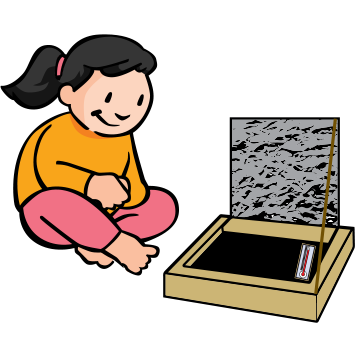Boston Children's Museum
308 Congress Street, Boston, MA 02210
617-426-6500
© Boston Children’s Museum 2025
Website Design by JackrabbitMost of the energy we consume comes, in some form or another, from the Sun, and the Sunlight we experience here on Earth contains a surprisingly large amount of energy. But children might not realize it based on the calm, pleasing warmth the Sun’s rays impart. In this activity students investigate just how much the energy found in Sunlight can do, if properly harnessed.
Solar ovens work! But, they heat up slowly. This is a great summer camp activity, and a good one to set up early in the day, then check over a period of time. These ovens also work best when it is sunny and warm, so wait for a nice, sunny day. Some afterschool programs have had great success with breaking this activity in to two sessions – the first, building and testing the ovens, and the second, using the ovens to cook s’mores, cookies, and more.
It might also help for you to create an example oven ahead of time for students to refer to.

Ask your students if they have ever sat outside on a sunny day. What did they notice about how the sunlight felt on their skin? If they stayed in the sun for a long time, did they get warmer, cooler, or stay the same? The Sun produces a lot of energy, and that energy heats the Earth, feeds plants and trees, drives our weather, and more. If you can, show them NASA images of the Sun, like these: http://solarsystem.nasa.gov/planets/sun/galleries. If we use the right materials, we can absorb and trap some of that energy found in sunlight, and even use it to accomplish something…like maybe cooking up some snacks!
Harness the power of the Sun in the name of snack time!
After they first set up their ovens, have the whole group come together and predict what will happen. Do they think their ovens will heat up? Was it tricky trying to get the angle of the aluminum foil flap just right? How hot do they predict their ovens will get? How long will they take to heat up to their hottest point? What are some other contraptions that use the Sun’s energy, like these ovens, and how might they be similar to the ovens? Some examples could include greenhouses (the plastic window in the pizza box oven is like the glass of a greenhouse, trapping (infrared) energy inside the pizza box); and solar panels, which are often seen on rooftops or on Satellites. Like the pizza box, these usually have a dark (blue) background that absorbs a lot of light, and of course you have to point them towards the sun to make them effective.
Have teams check the temperature in the ovens every 10 minutes, and record those temperatures. After each of these 10-minute observations, teams should share their thermometer readings and any observations with the other teams. What is happening inside the ovens? Do some ovens have different readings? What might contribute to those different temperatures (location, flap angle, tightness of the plastic wrap seal, etc.)? When you reach the point that the ovens have the same (or close to it) temperature after two readings, it is time to get cooking! A note: In some trials using a solar oven that was made based on this design, at 85 to 90 degrees F on a sunny afternoon it took about 30 to 35 minutes for the marshmallow to get warm enough to become soft and melt some of the chocolate to make a tasty, solar-powered treat. In ideal conditions this solar oven can easily heat up to about 160 to 200 degrees F. Using full, direct sunlight is important for heating this solar oven. MAKE SURE OVENS ARE FACING THE SUN! Believe it or not, sometimes teams might forget this important factor.
Cooking Materials
Questions to consider together while the s’mores are cooking: How did the black paper help things in oven cook? What does the foil do? Does it help to keep the box closed? Why?
The solar oven in this activity is a relatively simple one made out of a pizza box, aluminum foil, plastic wrap and a sheet of black paper. The aluminum foil in this oven reflects sunlight into the box. The plastic “window” works like a greenhouse roof, allowing (direct and reflected) sunlight to pass into the box, while also retaining heat. At the bottom of the box, the black paper acts as a heat sink that absorbs direct and reflected sunlight to warm it, which heats food placed on top of it.
Earth and Space science activities were developed with the support of NASA. This material is based upon work supported by NASA under grant award number NNX14AQ83G. Any opinions, findings, and conclusions or recommendations expressed in this material are those of the author(s) and do not necessarily reflect the views of the National Aeronautics and Space Administration (NASA).